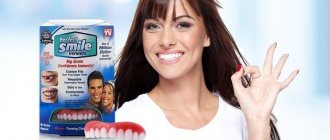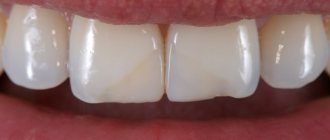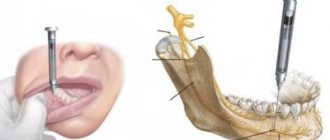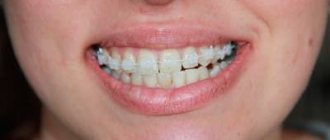Have you had your teeth whitened and your doctor recommends following a white diet? Do you want to know the exact checklist of foods that, according to dentists’ recommendations, should not be consumed on a white diet. What can replace products with coloring pigments? Experts told us about this and much more.
The white diet is a special type of diet in which a person consumes non-coloring foods, that is, without pronounced pigment. The so-called transparent diet is prescribed after teeth whitening. A colorless diet is recommended for patients to consolidate the effect, preserve the resulting color of tooth enamel for as long as possible, and protect from exposure to various substances. Also, a white diet should be followed when whitening at home.
Clinical case with a transparent diet: the patient planned home teeth whitening. I purchased special products from the dentist (mouth guards with gel) and consulted with a dentist. It is recommended to adhere to a colorless diet throughout the entire whitening period (about a week), as well as for another 7–10 days after the end of the course.
Following a colorless diet is important not only for maintaining the effect of the procedure. You should not subject additional tests to tooth enamel, which is somehow weakened after whitening procedures and has a porous structure. In two to three weeks of the white diet, the enamel will be restored, and you will be able to return to your usual lifestyle, but with certain nuances in the pigment content of the products.
How strictly should you follow the white diet?
As much as possible with a diet. For example, in order for the effect to last for a long time, when on a white diet, you should avoid foods with coloring pigments for 2 to 3 weeks after the procedure.
Also, as part of the white diet, experts advise gradually introducing useful habits: partially or completely giving up red wine, coffee or black tea, drinking colored drinks through a straw, replacing the same tea with kefir or milk.
Remember! Pigment substances are not harmful to healthy tooth enamel, but in the presence of inevitable microdamages after bleaching, dyes can penetrate deep into it and stain it.
The most important thing in the white diet is to pay attention to the color of the foods. The diet has no strict restrictions on the quantity or variety of food products.
Dentistry for those who love to smile
+7
Make an appointment
Products that you can eat
After such an impressive list of prohibitions, the question arises: what can you eat without fear?
In fact, there are not as few permitted products as it might seem at first glance:
- Dairy products – natural kefir, cottage cheese, yogurt without dyes
- Cheeses
- Fruits: green and yellow apples, pears, white grapes, bananas
- Vegetables: cauliflower and white cabbage, celery, cucumbers, mushrooms, beans
- White meat, fish, seafood, eggs
- White wine is acceptable for alcoholic drinks
- Sweets – white marshmallows, marshmallows, white ice cream
Let's summarize the above:
Following a transparent diet in the first 7-10 days after the whitening procedure will protect the new white color of the enamel from external coloring pigments and allow the result to consolidate. A snow-white smile – isn’t this a worthy reward for such a short restrictive period?
In the future, try to limit the intake of coloring products that contribute to the appearance of unwanted pigmentation of the enamel. Of course, it is impossible to eliminate the entire list of listed undesirable foods from our diet forever, but it would not hurt to make a rule - if you have eaten or drunk any drink from the “prohibited list,” then you need to brush your teeth with a brush and toothpaste as soon as possible, or better yet. immediately after eating.
If you DO NOT like the temporary effect of whitening, you DO NOT want to repeat the procedure every 1-2 years and comply with such restrictions, the best solution would be to install veneers or ultraneers. For a bright, beautiful smile, you will need to install at least 6 veneers on the upper jaw.
What exactly is not recommended to eat on a white diet? Stop list of products
The white diet excludes the following foods from the diet:
- black and green tea. By the way, it is green tea that causes plaque to form on teeth extremely quickly. This product should also be excluded from the white diet so that your teeth do not darken after whitening;
- bright sauces: tomato, soy, adjika, ketchup, etc.;
- coffee, cocoa are obvious stop drinks of a transparent diet;
- colored fruits: plums, dark grapes, red apples;
- fruit and vegetable juices, compote, fruit drink;
- chocolate, lollipops, dragees;
- citrus;
- jam;
- egg yolk;
- red wine.
The culprits of the problem
Many foods and drinks contain natural or artificial coloring substances that, to one degree or another, change the shade of tooth enamel. To avoid darkening or yellowing of crowns, it is worth knowing their list.
Tea
Black tea contains a large amount of active substances - tannins. Penetrating into the pores of the enamel, they connect with the cells of the dental tissue, giving the teeth a yellowish tint.
To prevent the appearance of pigmented areas of the enamel after each tea drinking, it is necessary to brush your teeth or use a mouth rinse.
At the same time, tea has a pronounced bactericidal effect, thanks to which it protects the gums from the effects of microorganisms. Green and white teas are recognized as the safest and healthiest for enamel.
Coffee
Coffee contains heavy carbohydrates, cocoa butter and the same sugar in quantities dangerous to enamel. They are able to penetrate deep into the pores of dentin, leading to the formation of plaque and the appearance of yellowish-gray pigment spots on the enamel.
If you do not clean your teeth in a timely manner after drinking a coffee drink, such pigmented areas can eventually be removed only through in-office whitening.
In addition, drinking coffee contributes to a change in acidity in the mouth, leading to an increase in the number of bacteria and the formation of stones.
Fruit juices
Natural juices squeezed from dark fruits and berries are rich in phosphoric acid. Under its influence, the top layer of enamel is destroyed and numerous pores form in it.
Due to the penetration of natural pigment substances, which are rich in juices, into the resulting gaps, the teeth acquire a reddish, bluish or other tint, depending on the color of the berries used.
Juices from dark berries – blueberries, cherries, blueberries – have the greatest coloring effect. Most often, enamel that has changed color can be easily restored to whiteness with the help of toothpaste and mouthwash.
Detailed instructions for using Dental Drops and a review of analogues. Click here if you are interested in Amazing White oxygen teeth whitening.
At this address https://dr-zubov.ru/ortopediya/nesemnye-protezy/koronki/keramicheskaya-vybiraem-luchshee.html we suggest looking at photos of ceramic crowns for the front teeth.
Berries
Berries have a lesser effect on tooth enamel than juices. This happens because when they are consumed, saliva is released, which neutralizes the aggressive effects of coloring components. .
The consumption of currants, blackberries, blueberries, mulberries, cherries, and blueberries causes a temporary change in the color of the enamel. Bluish pigmentation can be easily removed using standard hygiene products.
However, it is worth remembering that frequent consumption of dark berries and untimely care of the crowns can lead to their yellowing.
Carbonated drinks
Carbonated drinks contain large amounts of sugar and various acids. These components have an aggressive effect on the enamel, thinning its top layer and opening the pores.
Artificial dyes present in such drinks penetrate through open pores into enamel prisms and settle in them. In addition to the darkening that occurs over time with regular consumption of soda, the enamel becomes susceptible to carious lesions.
Watch the video to see how carbonated drinks affect tooth enamel.
Chocolate
The effect of chocolate on the tooth surface depends on its type.
Milk chocolate contains a large amount of sugar, which gradually destroys tooth enamel, contributing to its staining under the influence of chromogens from various products.
In addition, milk chocolate and candies with glaze provoke the appearance of an unpleasant odor from the mouth.
Dark chocolate with at least 56% cocoa content has a positive effect on teeth.
Cocoa butter envelops the crowns with a protective film, protecting them from damage. In addition, the antiseptic properties of cocoa beans are known. They fight the formation of plaque and stone.
Learn more about when to start brushing your child's teeth and how to get him used to brushing his teeth every day. In this article, we suggest finding out how much it costs to insert a metal-ceramic tooth, the price of crowns and specialist services.
Follow the link https://dr-zubov.ru/krasota-i-uxod/sredstva/zubnye-niti/kak-pravilno-i-bezopasno-polzovatsya.html and watch a video on how to use dental floss.
Sauces and seasonings
Many dark-colored sauces, such as soy or balsamic vinegar, have a sour taste and contain acids that damage the integrity of the top layer of tooth enamel.
As a result, the chromogens contained in these products penetrate through the pores of dental tissue deep into the dentin surface and become fixed there.
Tomato paste and sauces prepared on its basis are also among the coloring products, after consuming which you need to brush your teeth or use a mouthwash.
Dentists recommend using dark sauces as little as possible and, if possible, replacing them with light analogues, for example, lemon juice or rice sauce.
Red wine
The burgundy hue of red wine and the abundance of tannins in it lead to significant staining of the surface of the crowns. In addition, the enamel's sensitivity to high and low temperatures increases.
White wine is no less harmful to the tooth surface. It contains acids that promote the formation of microcracks in the enamel, which facilitates the penetration of coloring pigments into the deeper layers of dentin.
Over time, teeth acquire a persistent grayish-yellow tint.
Beet
Beets have a rich burgundy color, which when consumed instantly colors the surface of the crowns. The vegetable contains a huge amount of chromogens. These organic pigments are able to penetrate even the smallest pores present on intact enamel.
Regular consumption of beets leads to deep penetration and stable fixation of chromogens on the dentin surface, which gives the crown a dirty yellow tint.
Eating dishes containing beets requires timely cleaning of the dentition or rinsing it with water or special preparations.
Spices
Some spices, such as curry and turmeric, which have a rich yellow color, can contribute to discoloration of crowns. The high concentration of color pigment in these products is not lost even during heat treatment.
Frequent consumption of foods containing these spices over time leads to yellowing of tooth enamel and even acquiring a reddish tint.
In order to timely neutralize color pigments, it is recommended that after each meal containing turmeric, rinse the mouth with water and lemon juice.
Turnip
Turnips are vegetables whose heat treatment enhances the release of coloring elements and their penetration into the pores of the tooth surface. Therefore, dishes with boiled or baked turnips contribute to the coloration of the tooth surface in a pale yellow tint.
The effect of color change from taking this product is short-term; after cleaning the crowns with a toothbrush and toothpaste, they acquire a natural white color.
Candy with food coloring
Numerous sweets, such as caramel, chewing gum, and marmalade, contain a large number of synthetic dyes.
The use of such products leads to a short-term change in the color of the tongue and enamel.
However, if you often eat sweets, the artificial pigments and sugar present in their composition will gradually destroy the enamel and penetrate deeper into the pores of the tooth. Over time, the tooth surface will become grayish in color.
To avoid this, after each use of sweets, you need to brush your teeth with a toothbrush and toothpaste and rinse your mouth with special products.
What happens if you break the rule of the white diet?
Nothing catastrophic, but the effect of teeth whitening will no longer be the most ideal. Firstly, a thin film of pigment deposits will do its job - the color will darken. Secondly, if the diet requirements are violated, the very shine and sparkle of the enamel will disappear, for which many patients love whitening so much. Thirdly, the patient himself will see the difference in his teeth, and he will be offended that, for the sake of a moment of weakness or inattention, he ruined the aesthetics of a perfect smile. There is also a risk of tooth decay or inflammatory gum disease.
What causes the color to change
Discoloration of enamel occurs as a result of thinning of its top layer, which leads to exposure of pores. This situation contributes to the unhindered penetration of chromogens into them - organic pigments contained in products.
Often the cause of enlarged pores is the use of products containing acids, which help loosen the enamel.
Thinning enamel occurs in people of all ages. In adults, changes in dental tissue can be age-related; in young people, they can be caused by frequent consumption of acid-containing drinks or foods.
Berries
The rich color of the pulp and skin of blueberries, blueberries, black currants, cherries, cranberries, grapes, blackberries and raspberries stains teeth, giving them the characteristic shade inherent in berries.
Startsmile tip:
Berries are very good for health, so you shouldn’t give them up. Rinsing your mouth after eating with a special whitening rinse will help neutralize the effect of coloring pigments.
Maintaining the whitening effect
Do not forget about general recommendations for oral care, namely:
- Visit your dentist regularly.
- Take care of your teeth. There are special devices for cracking nuts.
- Get rid of bruxism (creaking at night). This habit leads to thinning and the formation of microcracks.
- Don't forget to floss after every meal.
These are only general recommendations that lead to damage to the integrity of the enamel and discoloration. All people have teeth, and caring for them today has become a cultural tradition, and not just a tribute to fashion and external beauty.
Are sports drinks bad for your teeth?
Sugary drinks are not good for your teeth at all. Other, acidic drinks, such as lemonade, can erode enamel over time. Long-term use of such drinks makes teeth more susceptible to substances that corrode enamel.
If you allow yourself to drink these drinks, then you should also remember the rule for cleaning a stain from a T-shirt: rinse with water and brush to reduce or stop staining.
On the subject: Habits that destroy teeth
Back to contents
Adviсe
Some tips will help you avoid discoloration of enamel when consuming coloring products and minimize the negative impact on crowns.
Is it possible to avoid staining?
You can avoid tooth pigmentation by adhering to the following recommendations:
- It is advisable to replace all coloring drinks with plain water or mineral water. to rinse your mouth with water afterward ;
- You should not include this type of product in the evening menu , since at this time of day the salivary glands reduce the production of saliva and its quality deteriorates;
- For drinking drinks, it is best to use cocktail straws . This will reduce the likelihood of them getting on your teeth;
- to brush your teeth as soon as possible using toothpaste and a brush;
- regularly carry out preventive bleaching using bleaching paste and rinses.
This video talks about ten healthy foods for teeth:
What foods should you not brush your teeth after?
In some situations, using a brush and paste directly after consuming certain products is unacceptable. These include acid-containing species:
- sauces;
- fruits;
- wine;
- soda;
- berries.
These products can soften and loosen enamel. Exposure to it with a brush will lead to additional deformation of the surface, which contributes to the accumulation of bacteria and the occurrence of inflammation of the periodontium and dental tissue.
Clinical researches
Clinical studies have proven that regular use of ASEPTA professional toothpaste improved the condition of the enamel by 64% and reduced tooth sensitivity by 66% after just 4 weeks.
Sources:
- Report on the determination/confirmation of the preventive properties of personal oral hygiene products “ASEPTA PLUS” Remineralization doctor-researcher A.A. Leontyev, head Department of Preventive Dentistry, Doctor of Medical Sciences, Professor S.B. Ulitovsky First St. Petersburg State Medical University named after. acad. I.P. Pavlova, Department of Preventive Dentistry
- Report on determining/confirming the preventive properties of toothpaste “ASEPTA PLUS” COFFEE and TOBACCO Author: doctor-researcher A.A. Leontyev, head Department of Preventive Dentistry, Doctor of Medical Sciences, Professor S.B. Ulitovsky. First St. Petersburg State Medical University named after. acad. I.P. Pavlova, Department of Preventive Dentistry
- Report on determining/confirming the preventive properties of toothpaste “ASEPTA PLUS” GENTLE WHITENING” Author: doctor-researcher A.A. Leontyev, head Department of Preventive Dentistry, Doctor of Medical Sciences, Professor S.B. Ulitovsky First St. Petersburg State Medical University named after. acad. I.P. Pavlova, Department of Preventive Dentistry
- Clinical and laboratory assessment of the influence of domestic therapeutic and prophylactic toothpaste based on plant extracts on the condition of the oral cavity in patients with simple marginal gingivitis. Doctor of Medical Sciences, Professor Elovikova T.M.1, Candidate of Chemical Sciences, Associate Professor Ermishina E.Yu. 2, Doctor of Technical Sciences Associate Professor Belokonova N.A. 2 Department of Therapeutic Dentistry USMU1, Department of General Chemistry USMU2
- Clinical studies of antisensitive toothpaste “Asepta Sensitive” (A.A. Leontyev, O.V. Kalinina, S.B. Ulitovsky) A.A. LEONTIEV, dentist O.V. KALININA, dentist S.B. ULITOVSKY, Doctor of Medical Sciences, Prof. Department of Therapeutic Dentistry, St. Petersburg State Medical University named after. acad. I.P. Pavlova
- The role of anti-inflammatory rinse in the treatment of periodontal diseases (L.Yu. Orekhova, A.A. Leontyev, S.B. Ulitovsky) L.Yu. OREKHOVA, Doctor of Medical Sciences, Prof., Head of Department; A.A. LEONTIEV, dentist; S.B. ULITOVSKY, Doctor of Medical Sciences, Prof. Department of Therapeutic Dentistry of St. Petersburg State Medical University named after. acad. I. P. Pavlova










